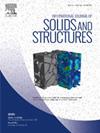Data-driven design of well-behaved nonlinear structures: A case study on the von Mises truss
IF 3.4
3区 工程技术
Q1 MECHANICS
International Journal of Solids and Structures
Pub Date : 2024-11-29
DOI:10.1016/j.ijsolstr.2024.113146
引用次数: 0
Abstract
Well-behaved nonlinear structures, which exploit elastic instabilities for functionality, have garnered increasing interest for rapid shape shifting and energy dissipation applications. One of the current bottlenecks during design is the large computational cost associated with nonlinear solvers when targeting a specific function through inverse design. Advances in machine learning (ML) tools have enabled a more efficient inverse design process. However, generating sufficient data efficiently to train the ML models still remains a challenge. This paper presents a novel computational toolbox that automates the generation of nonlinear finite element models, submission of analyses, monitoring of ongoing analyses, termination of analyses upon meeting specified criteria, and post-processing of results. With this computational toolbox, we develop three types of ML models: two forward models that classify and characterise nonlinear equilibrium paths based on the structure’s properties (material and geometry), and one backward model for predicting the structure’s properties from key features of the nonlinear equilibrium path. We evaluate various ML algorithms for each model type, provide recommendations, and explore algorithmic modifications to enhance prediction accuracy To illustrate the effectiveness of the proposed tools, we present two case studies where the von Mises truss plays a key role: (a) a recoverable energy dissipating mechanical metamaterial and (b) a vibro-impact capsule robot. Our findings highlight the potential of data-driven approaches to efficiently enable the design of high-performance nonlinear structures that harness instabilities for targeted functionalities.

求助全文
约1分钟内获得全文
求助全文
来源期刊
CiteScore
6.70
自引率
8.30%
发文量
405
审稿时长
70 days
期刊介绍:
The International Journal of Solids and Structures has as its objective the publication and dissemination of original research in Mechanics of Solids and Structures as a field of Applied Science and Engineering. It fosters thus the exchange of ideas among workers in different parts of the world and also among workers who emphasize different aspects of the foundations and applications of the field.
Standing as it does at the cross-roads of Materials Science, Life Sciences, Mathematics, Physics and Engineering Design, the Mechanics of Solids and Structures is experiencing considerable growth as a result of recent technological advances. The Journal, by providing an international medium of communication, is encouraging this growth and is encompassing all aspects of the field from the more classical problems of structural analysis to mechanics of solids continually interacting with other media and including fracture, flow, wave propagation, heat transfer, thermal effects in solids, optimum design methods, model analysis, structural topology and numerical techniques. Interest extends to both inorganic and organic solids and structures.

 求助内容:
求助内容: 应助结果提醒方式:
应助结果提醒方式:


